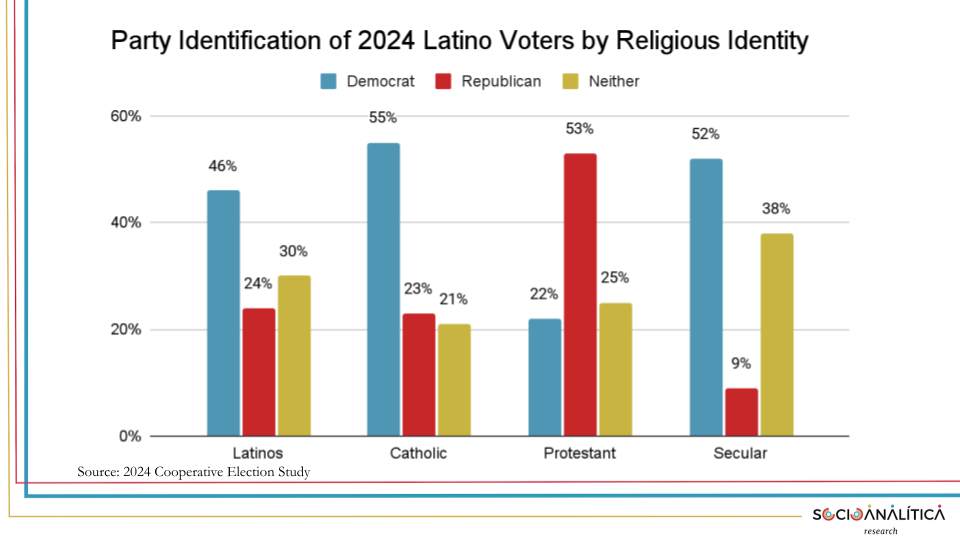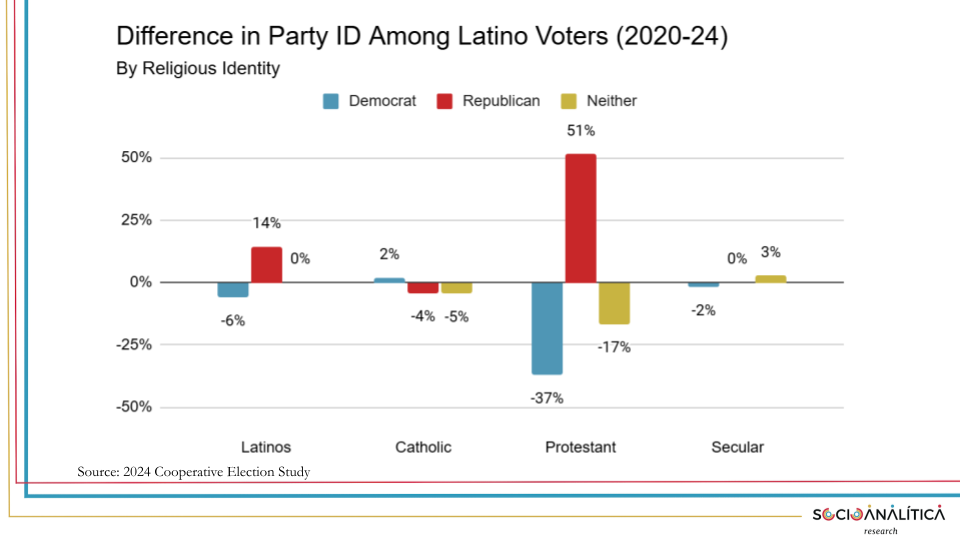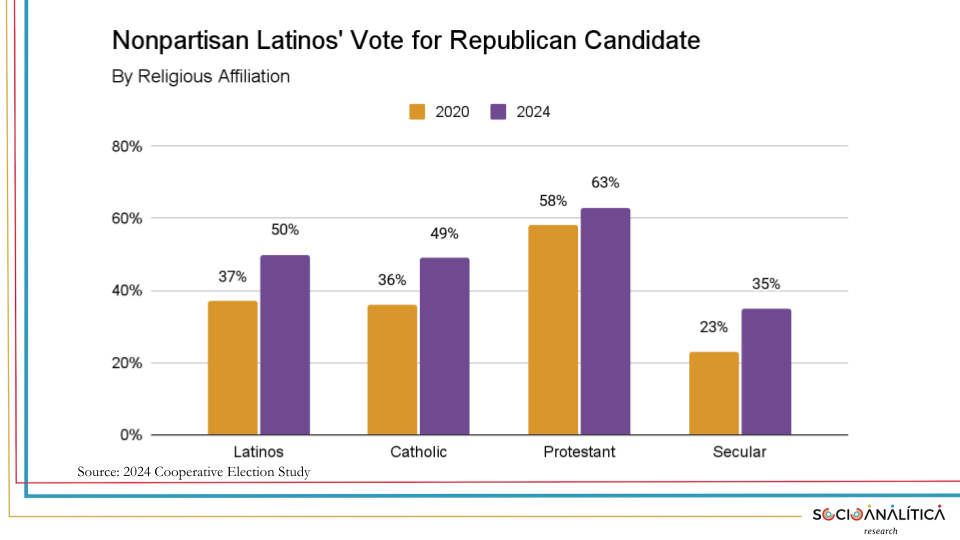How Latino Voters Shifted in 2024
Sep 30, 2025 6:01 pm
In the last three weeks, we have learned a lot about the religious composition of Latinos, as well as the beliefs and behavior of secular Latinos. Last week, we discussed the Latino vote by religion in the previous election. On the one hand, the GOP made inroads among Christian Latinos. In contrast, secular voters are now the largest Latino cohort within the Democratic Party coalition.
Today, we’re going to focus on where I think the change happened. I guess that there are two major changes: one is a major abandonment of the Democrats among Latinos and other Christians, who are not Catholic; the other is a defection of independent voters away from the Democrats.
Partisanship of Latino Voters in 2024
In the first chart, we are seeing the party identification of Latino voters using the Cooperative Electoral Study. Among all Latinos, the party identification is nearly a two-to-one ratio in favor of Democrats over Republicans, but the second largest cohort is those who support neither party. In fact, three in ten Latinos do not identify with either party, a plurality identify as Democrats, and about a quarter identify as Republicans.

Change in Party ID, 2020-2024
Compared to 2020, Latino partisan affiliation among voters has shifted dramatically, though the changes may not be as surprising as they seem. The second chart shows the percentage change in party affiliation among Latino voters by religion. The first bar indicates that Latino party identification declined by 6% among Democrats but increased by 14% among Republicans. This suggests that the proportion of Republicans in 2024 is much higher than in 2020, while the percentage identifying as Democrats has decreased.
For example, in 2020, 49% of Latinos identified as Democrats, but this dropped by 3 percentage points, or 6%, to 46% in 2024. Meanwhile, Republican identification rose from 21% to 24%, which is a 3 percentage point increase, or 14% relative to the 2020 base of 21%. Because the starting base among Republicans was lower, the proportional increase of 3 percentage points is actually greater than the 3 percentage point loss among Democrats between the two years. The proportion of Independents has remained consistent at 30% in both elections. Overall, we find that the electorate is slightly more Republican than it was in 2020.
Considering this, we can observe that, among Catholics, the difference is not particularly significant. The proportion of Democrats compared to Republicans has remained the same since 2020, with a 2% increase among Democrats, and a 4% and 5% decline among Republicans and independent or non-partisan Catholics.
A similar trend can be observed among secular voters, with a modest 2% decrease among self-identified Democrats, no change among self-identified Republicans, and a slight 3% increase among independent secular Latinos in 2024 compared to 2020.
What has truly changed between 2020 and 2024 is the partisan distribution among Latino Protestants and other Christians.
The partisan identification among Democratic voters has significantly declined among Protestant Latinos, dropping from 35% in 2020 to 22% in 2024. This represents a 13-point reduction in Democratic party identification within this group. On the other hand, Republican identification among Protestant Latinos increased from 35% to 53%, reflecting an 18-point gain, or a 51% increase in Republican identification between 2020 and 2024. This marks a substantial shift in the Protestant electorate compared to its composition in 2020.
What we have here is the first piece of the puzzle: a significant increase in support for Donald Trump between 2020 and 2024 can largely be attributed to a substantial decline in self-identifying Democratic Protestant Latino voters. Meanwhile, there has been a notable increase in Republican-leaning voters, shifting a previously evenly divided group towards strong Republican support.
This shift doesn't entirely explain the overall trend, but only Protestant voters have realigned with the Republican Party; a considerable portion of the overall shift in the Latino vote can be attributed to the changing dynamics of Protestant Latino voters in 2024.
What we don't know is whether individuals shifted their party affiliation, as these are findings from two distinct surveys. We cannot definitively say that people have changed parties, but it's likely that some individuals did.
The Independent Swing Vote
I analyzed the voting patterns and, while I'm not including specific numbers because they are quite unremarkable, I found that most Democrats supported Kamala Harris in the 2024 election, and Republicans largely backed Donald Trump in the 2020 election at a rate of approximately nine to one. Party members generally supported their party's candidate in 2024 to a similar extent as they did in 2020.
However, there was a notable shift among Latinos who identified as independent or nonpartisan. In 2024, these voters leaned towards the Republicans, whereas in the 2020 elections, they had predominantly voted for Democrats.
The last chart shows how Latino voters without party preference cast their ballots in 2024 compared to 2020. Overall, half of non-partisan Latinos supported Donald Trump in 2024, marking a 13-point increase from 2020, when 37% voted for him and the majority, 52%, voted for Joe Biden. This time, 46% of non-partisan Latinos voted for Kamala Harris.
The differences in voting patterns appear to be consistent across various religious groups. Among Catholics, support for Trump increased from 36% in 2020 to 49% in 2024. This shift transformed Catholics from a group that was strongly Democratic( 58% voted for Biden) into one that is more evenly divided, with 48% voting for Harris and 49% for Trump.
For independent secular voters, there was a slight decline in support for Democrats, with 63% voting for Biden in 2020, compared to 59% supporting Harris in 2024. Interestingly, 35% of secular voters chose Trump in 2024, a significant increase from just 23% in 2020. It appears that rather than a shift from Democrat to Republican, a notable portion of the secular electorate (14% in 2020) voted for third-party or independent candidates, while only 6% did so in 2024. This suggests a movement away from third-party voting among secular Latino voters, with a discernible shift toward the Republican side in 2024.
Lastly, the Protestant non-partisan voters, who supported Trump in 2020 with a margin of 56% to 34%, slightly increased their support for him to 63% in 2024. However, the overall gains from this group were minimal, as their Republican support was already quite solid.
Tonight: Secular and Christian Latinos in Presidential Elections
Join me and Sarah Levin tonight, September 30, at 6:00 PM Eastern Time for a discussion about Secular and Christian Latinos in Presidential Elections. Event description below:
Today, nearly three in ten Latinos identify as nonreligious, representing a significant and growing segment of the community. Despite their size and increasing influence, discussions around religion in the Latino community often overlook this group, instead highlighting the diminishing numbers of Catholic and evangelical populations.
This presentation will focus on the changing demographics, beliefs, and electoral impact of secular Latinos. We will discuss how secular Latinos are shaping Latino electoral behavior and attitudes on important social and cultural issues.
Registration here.




